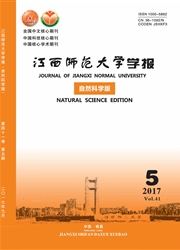

 中文摘要:
中文摘要:
采用分子动力学(Molecular Dynamics,MD)模拟方法,研究了1-丁基-3-甲基咪唑四氟硼酸盐([BMIM][BF4])离子液体在不同尺寸的金纳米粒子表面的结构性质.计算结果在分子水平上揭示了咪唑类离子液体在Au纳米粒子表面的结构特征与纳米粒子尺寸密切相关.通过分析,发现阳离子中的烷基侧链在小尺寸Au13纳米粒子表面聚集的最多,然而阳离子中的咪唑环则在大尺寸Au309纳米粒子表面聚集的最多.同时,取向分布也表明阳离子中的咪唑环倾向于分布在大尺寸Au309纳米粒子周围而不是小尺寸Au13纳米粒子.进一步的能量分析表明,阳离子中的烷基侧链与小尺寸的Au13纳米粒子相互作用能要强于阳离子中的咪唑环,而Au309纳米粒子则与咪唑环的相互作用能最强.此外,无论是对于小尺寸的Au13纳米粒子还是大尺寸的Au309纳米粒子,阴离子的相互作用能都是最小的.这预示着阴离子对于Au纳米粒子表面结构性质是典型的间接作用.
 英文摘要:
英文摘要:
The molecular dynamics simulations have been employed to study the structural properties of 1-butyl-3-methylimidazolium tetrafluoroborate( [BMIM][BF4]) ionic liquids surrounding Au nanoparticles with different sizes. The simulation results reveal for the first time that the structural properties of imidazolium-based ionic liquids in Au nanoparticles depend on the size of nanoparticles at a molecular level. The structural properties are dominated by the alkyl chains of cations in the case of Au13 nanoparticle were found,while the imidazolium rings have the most contributions in the case of larger Au309 nanoparticle. Meanwhile,the orientational distributions also show that cations prefer to locate on the Au309 nanoparticles surface. Furthermore,the relevant interaction energies indicate that the interaction between the alkyl chain and the Au13 nanoparticle much stronger than that from imidazolium rings,which is contrary to the behavior in the case of Au309 nanoparticle. In addition,all of the interactions between the anion and the Au nanopartciles is always the smallest regardless of the particle size,indicating that the anions have an indirect effect on the relevant structural properties.
 同期刊论文项目
同期刊论文项目
 同项目期刊论文
同项目期刊论文
 期刊信息
期刊信息
